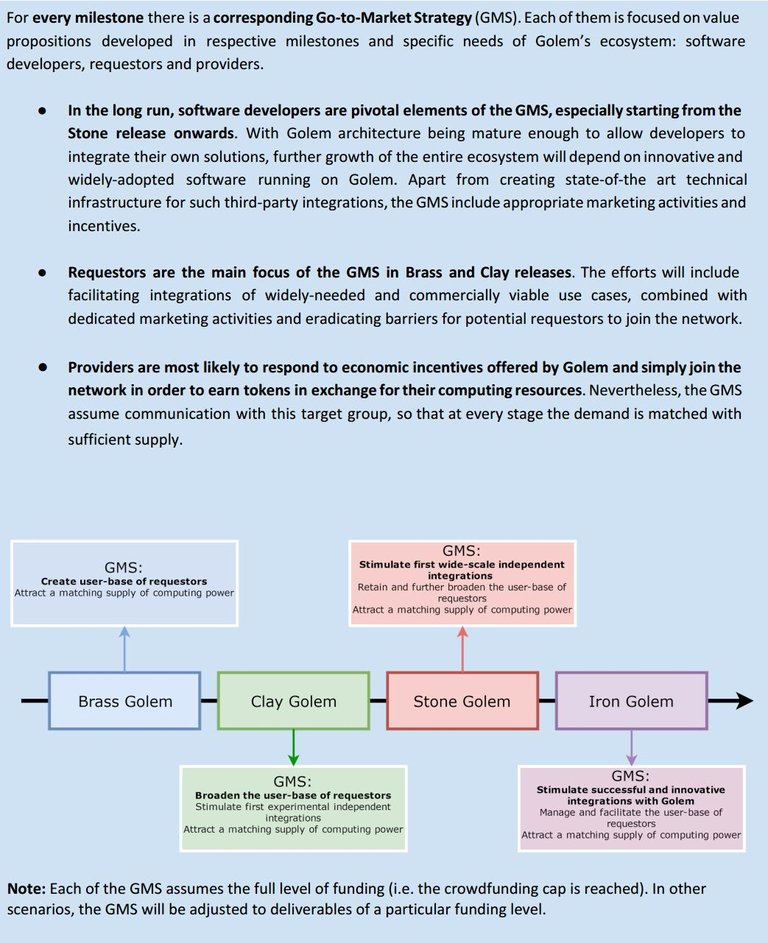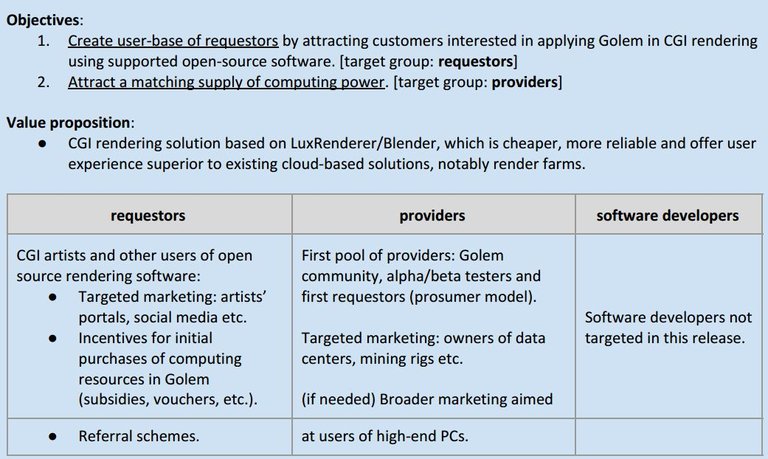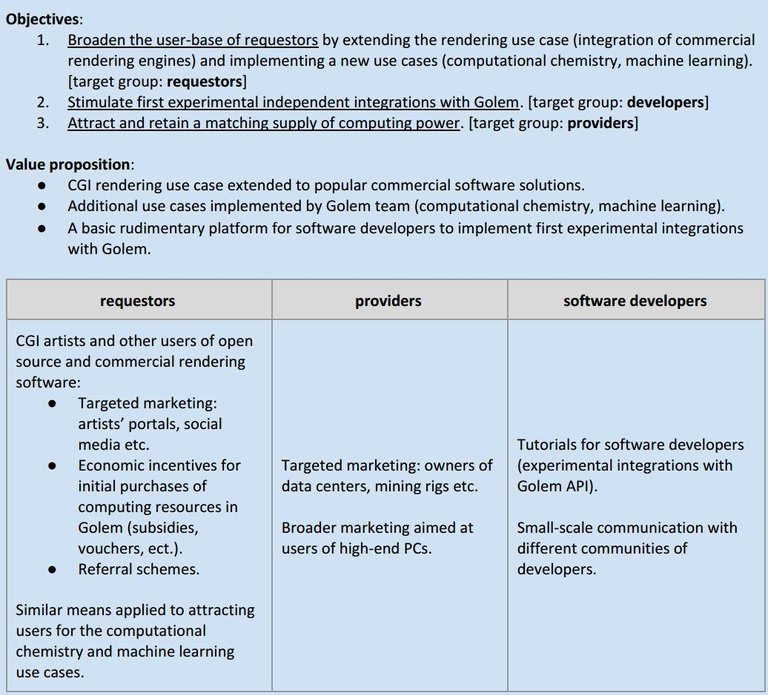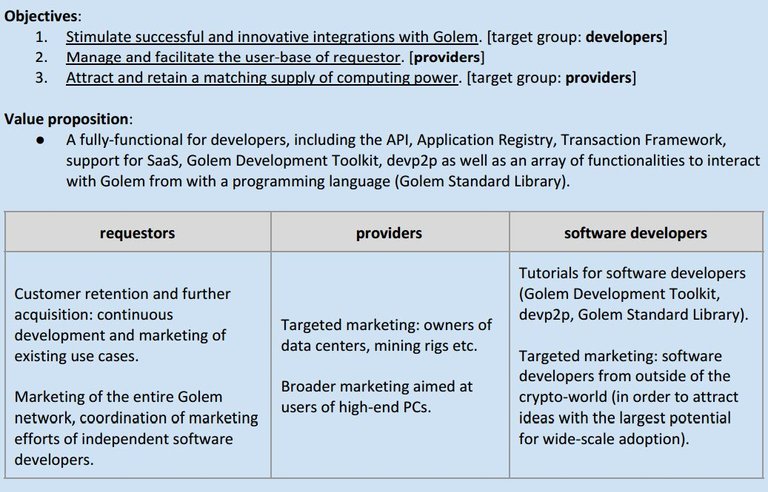i didnt see anywhere on steemit the roadmap of golem, so i thought i would share some info about.
Project Timeline

Go-to-Market Strategy

Milestones (Phases)
Brass Golem (May 2017)
Brass Golem is only focused on rendering in Blender and LuxRender, although it will be useful to CGI artists, we consider CGI rendering to be a proof of concept primarily, and also a training ground. Brass Golem should be frozen within 6 months after end of crowdfunding period and a full battery of tests. Even though we do not expect that Blender CGI rendering will create enough turnover to justify all the work we have put into the project, this will be the first decentralised compute market.
List of proposed functionalities:
- (1) Basic Task Definition Scheme that allows to prepare first task definition;
- (1) Basic Application Registry - first version of Ethereum-based Application Registry
which allows to save tasks defined with basic task definition scheme; - (1) IPFS integration for coordinating task data and content delivery, e.g. deliver files
needed to compute a task, deliver the results back to the requester; - (1) Docker environment with Golem-provided images for sandboxing the
computations; - (1) Local verification: a probabilistic verification system based on the calculation of a
fraction of the task on the requestor’s machine; - (1) Basic UI and CLI;
- (1) Basic reputation system;
- (1) Implementation of Blender and LuxRender tasks.
Go-to-Market Strategy (Brass)

Clay Golem (February 2018)
Clay Golem is a big leap from the Brass milestone. Clay milestone introduces the Task API and the Application Registry, which together are going to make Golem a multi-purpose, generalized distributed computation solution. Developers now have the means to integrate with Golem. This advance, however, may come at the cost of compromised stability and security, so this version should be considered an experiment for early adopters and tech enthusiasts. Prototype your new ideas and solutions on Clay. Clay Golem should be delivered within 15 months after end of crowdfunding period.
List of proposed functionalities:
- (1) Basic Task API: an interface that allows a user to define simple tasks;
- (1) Initial Transaction Framework Model with hard-coded payments schemes;
- (1) Redundant verification: a verification scheme based on the comparison of
redundant computation results; - (1) Basic subtask delegation: a mechanism for more fined grained subtasks
distribution (e.g. can be used to help with creation of an ad-hoc proxy delegating tasks
in a more efficient manner); - (1) Basic tutorials for software developers;
- (2) Support for virtual machines as a sandbox for computation;
- (2) Set of extended tutorials for developers explaining how to implement their own
tasks for Golem network; - (2) Example computational chemistry use case implementation;
- (3) Example machine learning use case implementation.
Go-to-Market Strategy (Clay)

Stone Golem (November 2018)
Stone Golem will add more security and stability, but also enhance the functionalities implemented in Clay. An advanced version of the Task API will be introduced. The Application Registry will be complemented by the Certification Mechanism that will create a community-driven trust network for applications. Also, the Transaction Framework will create an environment that will allow Golem to be used in a SaaS model. Clay Golem should be delivered within 24 months after end of crowdfunding period.
List of proposed functionalities:
- (1) Full Task API: an interface that allows users to define tasks;
- (1) Application Registry: where developers publish applications ready to run on
Golem; - (1) Transaction Framework that allows a choice of remuneration models for task
templates; - (1) Basic Certification support for Software: A mechanism that allows users to
whitelist and blacklist applications, building a decentralized trust network; - (1) Support for SaaS: the possibility to add support for proprietary software which can
be used in tasks. Payments for task creators should also be implemented in the
application; - (1) Application Registry and Transaction Framework tutorials for developers;
- (2) SaaS tasks examples - example use cases that shows developers how to create
tasks available in SaaS model;
Go-to-Market Strategy (Stone)

Iron Golem (November 2020)
Iron is a deeply tested Golem that gives more freedom to developers, allowing them to create applications that use an Internet connection or applications that run outside the sandbox. Of course, the decision to accept higher-risk applications will still belong to the providers renting their compute power. Iron Golem should be robust, highly resistant to attacks, stable and scalable. Iron will also introduce various tools for developers that will make application creation far easier.Finally, the Golem Standard Library will be implemented. Assuming that maximum financing will be reached, Iron Golem should be delivered within 48 months after end of crowdfunding period.
List of proposed functionalities:
- (2) External data link: enables Golem to use resources and interface with software
outside of the Golem network; - (2) Host-direct mode: a trusted mode for explicitly whitelisted applications or
invulnerable environments, where Golem runs computation outside the Docker/VM; - (2) Certification support for Environments;
- (2) Network Status Dashboard - public website displaying basic stats about Golem
network; - (2) Additional security mechanism - tasks that uses public data link or host-direct
mode are particularly challenging for security. Additional means may be necessary to
make running those tasks safer for providers (eg. central audit oracles, agreements
contracts or code-execution observers may be implemented); - (2) Golem web client: a web interface for Golem nodes as an alternative to the native
GUI / console interface; - (3) Golem Developer Toolkit: a set of diagnostic and test tools to make creation
process of applications for Golem even easier; - (3) Reputation-system: reputation protocol that allows the node to effectively
supervise network behaviour; - (3) Advanced transaction system: a system that automatically tries to match
requestors with providers in a way that is most profitable to all participants; - (3) Golem Developer Toolkit tutorial
- (3) Provider dashboard - providing stats, graphs and more advance settings
management for providers; - (4) devp2p integration - changes in p2p and network protocols using new version of
devp2p; - (4) MapReduce and topological sorting of tasks: add the next abstraction layer,
allowing users to define more generic tasks that are interdependent; - (4) Golem Standard Library (Golem STD): language agnostic functionality providing access to the low level core components required to interact with Golem from within a programming language. Special attention will be paid to I/O functions exposed to tasks and subtasks related functionalities. Each supported programming language will have bindings to Golem STD. These bindings will serve as a means of extending the default standard library of the language in question (custom extensions provided by developers of programming languages will also be possible). With Golem STD an automatic task definition, independent from the operating system, will be possible. Golem STD will allow users to create Golem applications using different programming languages, which shall significantly increase the number of potential use cases and simplify task creation process.
- (4) Golem STD tutorial for developers
Go-to-Market Strategy (Iron)

that's all about the roadmap
if you would like to get some more info about project, just check the source!
source: https://golem.network/doc/Golemwhitepaper.pdf
Hi! I am a robot. I just upvoted you! I found similar content that readers might be interested in:
https://www.scribd.com/document/332010993/Golem-White-Paper
woah! thanks for this. I've been thinking about investing in golem and this will really help me make an informed decision.
im glad that someone found it useful! thanks ^^
Really useful man! thanks .. btw , Is pre-brass golem the same as brass golem?
the brass golem will probably be out in June.
according to this link: https://github.com/golemfactory/golem/milestone/11 the brass golem is done in 68 % for now ^^
Good job!
@dufe thanks for the post for an intresting read about Golem https://steemit.com/cryptocurrency/@pps/golem-cryptocurrency-to-solve-computation-power-tasks